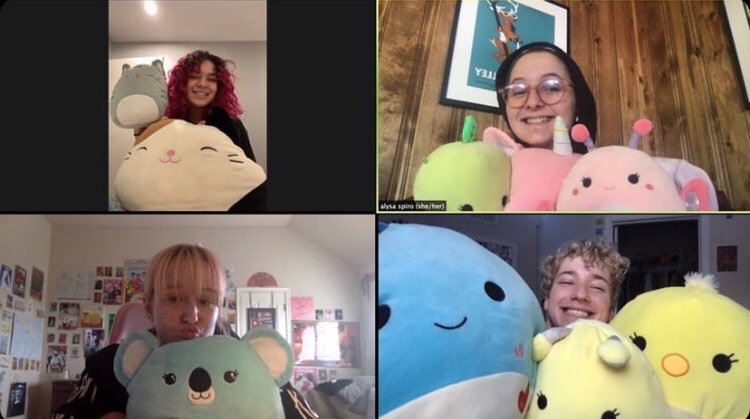Squishmallow craze contagious during pandemic
Hunted-after cylindrical stuffed animals have captivated American teenagers but is that good or bad?
Juniors Alysa Spiro, Eden Goodman, Venus Hicks, and senior Aydan Howison show off their collection of Squishmallows during an impromptu show and tell during AP Ethnic Studies class.
April 8, 2021
A cult has swept across America. Thousands of teens have been blinded by the cult’s charismatic leader, dedicating their time and money to move up the cult’s inner-hierarchy. Teens dream of having their room full of cult memorabilia, each object a sign of their utmost devotion to their leader. Non-cult members scowl at them on the street: “Why spend all your money on those weird, little things?”
The name of the oh-so-worshipped leader? The Squishmallow.
The Squishmallow is a brand of plushies that pride themselves on being the softest and cutest stuffed animals on the market. There’s over 500 different Squishmallows, each individual plush having its own name and backstory. Squishmallows have been popular since their 2017 founding, but during quarantine, they’ve gained an almost cult-like status.
Senior Ava Grace Light Whipple was first introduced to the Squishmallow via social media.
“I saw people talking about the pink Halloween cat on Twitter and immediately went to CVS to look for it,” Light-Whipple said. “After that, my friend Veronica Britton introduced me to the big, 16-inch Squishmallows. I saw the light and bought three of them.”
Since her initial introduction, Light-Whipple is a proud owner of eight Squishmallows, her favorite being Baby Yoda.
Britton, who introduced Light-Whipple to the large-sized Squishmallows, received her first Squishmallow for her birthday. However, she isn’t exactly the full-time owner of it anymore.
“My little sister Wren kept stealing the large Squishmallow I had received for my birthday. So I decided to let her have it,” Britton said. “Wren usually likes to fall asleep with headphones and the lights on, which I know that’s terrible for her sleep schedule. And it’s so nice, because I’ll go into Wren’s room every night, and I’ll turn off her lights and take off her headphones. And she’s just fast asleep on my big dinosaur Squishmallow, and it’s so sweet.”
Finding the Squishmallows themselves can be difficult. With the Squishmallow’s increased popularity, store racks dedicated to hosting Squishmallows can be completely empty days after a new shipment has come in. Because those searching for Squishmallows aren’t guaranteed to find any, a term within the Squishmallow community has popped up to describe these shopping trips: Squish-hunting.
Light-Whipple has had her fair share of squish-hunting trips.
“I typically go to the usual suspects like CVS, Walmart and 5 Below. But I had to order my last Squishmallow from Costco because they’ve been so hard to get my hands on recently. I don’t even have a Costco card,” Whipple said. “I like going ‘hunting’ for Squishmallows with my friends, but only a few places at a time.”
Squishmallow’s range in price, going from $2.99 for a smaller keychain-size to $59.99 for the larger, 24-inchers. As far as whether the Squishmallow is a worthy purchase, Light Whipple is split.
“On one hand, buying Squishmallows brings instant satisfaction,” she said. “On the other hand, I’m moving across the country in five months and probably won’t be bringing all of them with me to college.”
Britton theorizes that the increase in hype surrounding Squishmallows goes hand-in-hand with recent social media trends that revolve around decorating and beautifying living spaces.
“I think people are spending a lot of time in their beds. And especially in their rooms,” Britton said. “I don’t have TikTok, but I’ve seen the “room decor makeover” videos. Everyone’s really into making their space their own, which I love. And Squishmallows are a apart of that for many people. I think that’s great for people’s mental health.”
With this increased emphasis on having a nice living space, Britton believes that teenagers are more inclined to spend their money on Squishmallows.
“I think that because we’re in quarantine and can’t spend as much money with friends, some teenagers may have some excess income they’re not spending,” Britton said. “And Squishmallows are something that can help you make your space more comfortable and are a thing teenagers can justify spending their money on.”
But does the new Squishmallow trend accurately reflect the spending habits of most Americans? According to a 2021 post on the GreenBook financial blog, 49 percent of Americans are still purchasing luxury products during the pandemic. 46% of people are reportedly spending the same or more than they were before COVID hit.
Catherine Guiterrez, the author of the GreenBook blog post and VP of Marketing for the company, believes these spending statistics are heavily tied to American culture.
“Truth is, American culture is materialistic,” Guiterrez said. “If you tie success to materialism, then the more you have—the better you feel. And while it’s not that simple to ‘heal’ yourself by purchasing more, it can certainly create a short-term high.”
Apart from the possible financial therapy Squishmallow collecting may provide, Light Whipple also emphasizes the social benefits Squishmallow collecting may have for some people.
“I think one of the reasons Squishmallows have gained so much traction is quarantine is because people needed some thing to do,” Light-Whipple said. “Going on squish-hunts gave some people a reason to leave the house.”
All in all, however, Britton believes that it’s the plush itself that is the true cause of the Squishmallow’s explosive popularity.
“The Squishmallow feels like no other stuffed animal,” Britton said. “They are so cute, so soft and the right shape to really just love them.”






Melissa • May 9, 2021 at 9:40 am
Very well written and constructed! Love all the points of view and honestly. Nice job, Alysa! Keep it up